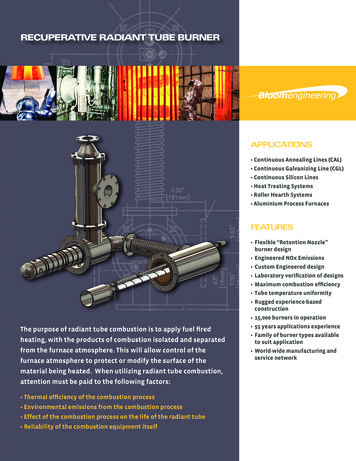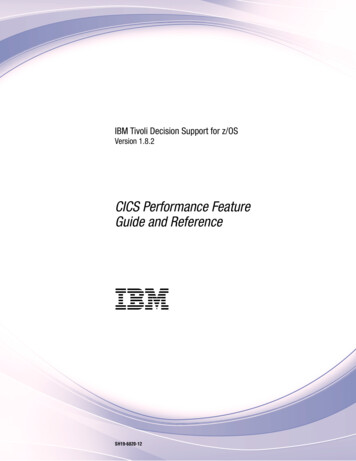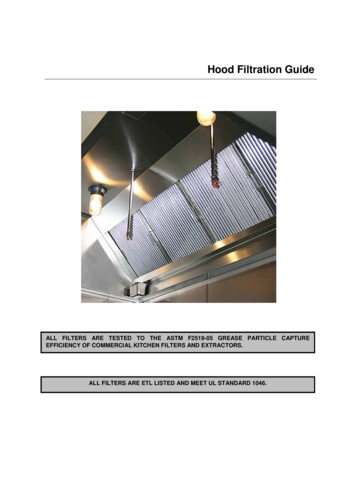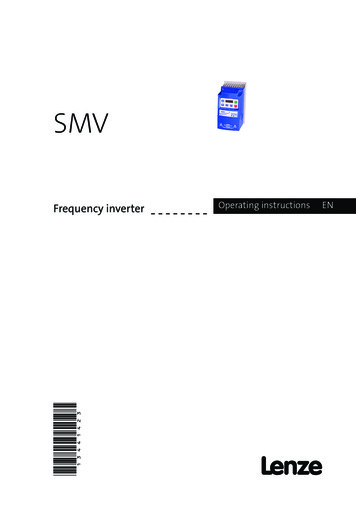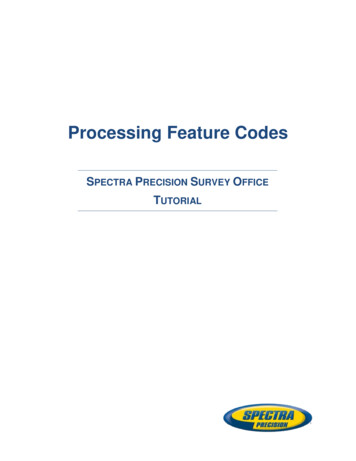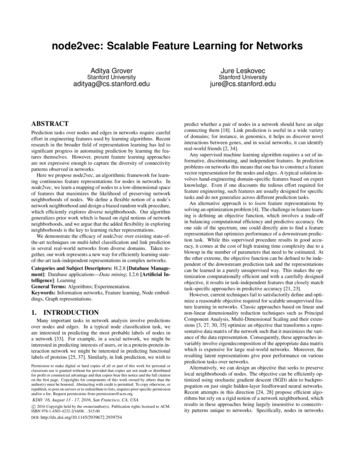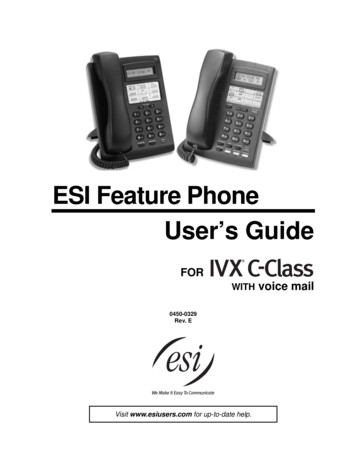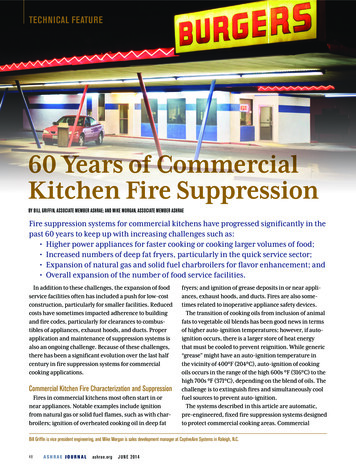
Transcription
TECHNICAL FEATURE60 Years of CommercialKitchen Fire SuppressionBY BILL GRIFFIN, ASSOCIATE MEMBER ASHRAE; AND MIKE MORGAN, ASSOCIATE MEMBER ASHRAEFire suppression systems for commercial kitchens have progressed significantly in thepast 60 years to keep up with increasing challenges such as: Higher power appliances for faster cooking or cooking larger volumes of food; Increased numbers of deep fat fryers, particularly in the quick service sector; Expansion of natural gas and solid fuel charbroilers for flavor enhancement; and Overall expansion of the number of food service facilities.In addition to these challenges, the expansion of foodservice facilities often has included a push for low-costconstruction, particularly for smaller facilities. Reducedcosts have sometimes impacted adherence to buildingand fire codes, particularly for clearances to combustibles of appliances, exhaust hoods, and ducts. Properapplication and maintenance of suppression systems isalso an ongoing challenge. Because of these challenges,there has been a significant evolution over the last halfcentury in fire suppression systems for commercialcooking applications.Commercial Kitchen Fire Characterization and SuppressionFires in commercial kitchens most often start in ornear appliances. Notable examples include ignitionfrom natural gas or solid fuel flames, such as with charbroilers; ignition of overheated cooking oil in deep fatfryers; and ignition of grease deposits in or near appliances, exhaust hoods, and ducts. Fires are also sometimes related to inoperative appliance safety devices.The transition of cooking oils from inclusion of animalfats to vegetable oil blends has been good news in termsof higher auto-ignition temperatures; however, if autoignition occurs, there is a larger store of heat energythat must be cooled to prevent reignition. While generic“grease” might have an auto-ignition temperature inthe vicinity of 400 F (204 C), auto-ignition of cookingoils occurs in the range of the high 600s F (316 C) to thehigh 700s F (371 C), depending on the blend of oils. Thechallenge is to extinguish fires and simultaneously coolfuel sources to prevent auto-ignition.The systems described in this article are automatic,pre-engineered, fixed fire suppression systems designedto protect commercial cooking areas. CommercialBill Griffin is vice president engineering, and Mike Morgan is sales development manager at CaptiveAire Systems in Raleigh, N.C.48ASHRAE JOURNALashrae.orgJ U N E 2014
TECHNICAL FEATUREThis article was published in ASHRAE Journal, June 2014. Copyright 2014 ASHRAE. Reprinted here by permission from ASHRAE at www.captiveaire.com. Thisarticle may not be copied nor distributed in either paper or digital form by other parties without ASHRAE’s permission. For more information about ASHRAE, visitwww.ashrae.org.cooking areas include associated ventilating equipmentsuch as exhaust hoods, filters, plenums, exhaust ducts,and fans; as well as commercial cooking appliances.Commercial kitchen fire suppression systems are generally suitable for use in restaurants, hospitals, nursinghomes, hotels, schools, airports, banquet services, andother food service facilities.First Hood Cleaning and Fire Suppression SystemIn the period from 1957 to 1965, an inventive entrepreneur received U.S. patents for exhaust hood featuresthat included grease extracting baffles, a fire damper,water or steam cleaning of the hood plenum, and firesuppression by water.1 Systems included automatic control of hood cleaning, and thermostatic control of thefire damper and water-based fire suppression. Thesepatents are significant in their descriptions and understanding of the challenges of grease fires in exhausthoods and ducts, and these patents foreshadowed manysubsequent developments.Fire Suppression Evolution1957 to 1965 Patents issued for hood with watercleaning and fire suppression1959 First dry chemical system1961 NFPA 96 first published1962 Improved dry chemical systems1964 First wet chemical system1969 Fuel shutoffs introduced1982 Large chain acceptance of wet chemical systems1992 UL Standard 300 published1992 and beyond Systems retested to UL 3001994 UL Standard 300 approved and required on allnew installations1998 Hybrid systems developed with wet chemicalsand water2007 First electronically controlled fire suppressionand hood cleaning systemFire Detection by Fusible LinksThere is a long history of using fusible links for firedetection, and this type of automatic detection is still inwidespread use. The construction of fusible links includestwo metal links, which are held together by a temperature-rated metal alloy. Different temperature ratings areavailable based on needs of applications. When the ratedtemperature is reached, the alloy fuses (melts) and a cableattached to the links activates the system. A comparison offusible links and alternative detection devices is providedin the accompanying sidebar text.Early Dry Chemical SystemsSystems with dry chemical suppression agents weredeveloped during the late 1950s, coincident with therapid expansion of quick service restaurants, manyof which included deep fat fryers. These fire systemsbecame especially popular after a large chemical andequipment manufacturing company released its firstgeneration pre-engineered, automatic system in 1962.This system employed one or two sensing assemblies,each with a spring and fusible links in the hood plenum. When the links separated, steel aircraft cableinside 3/8 in. (9.5 mm) diameter galvanized piping waspulled by the spring to trigger the release mechanism,which then punctured a gas cylinder mounted onFIGURE 1: Typical fusible links and bracket assembly.the outside of the chemical cylinder. The dry chemical agent then flowed through piping to spray headsdesigned for this purpose. These systems were typicallyinstalled to protect the hood plenum and ducts only.Limitations of this early technology included open exposure of the release mechanism, gas cartridge, and chemical cylinder. Also, the pulled cable system was limited totwo detector assemblies, which were connected in parallelto a tee, from which the release mechanism was activated.Improved Dry Chemical SystemsSoon after the initial development and increasing adoption of dry chemical systems, improvements were implemented, including use of inexpensive electric conduit ascable piping and development of pulley-elbows to minimize possible cable fouling at piping turns. Additionally,the spring was moved from the detector area to the gas andagent cylinder location. With this arrangement, the cableJ U N E 2014ashrae.orgASHRAE JOURNAL49
TECHNICAL FEATUREwas under continuous tension, and multiple detectorscould be connected in series. Significantly, protection forappliances was added at this time.Another improvement was the development of sealablemetal cabinets to hold the dry chemical cylinder, gas cylinder, and pressure-regulated release assembly. The cabinet would be unsealed and accessed only during periodicmaintenance by an authorized technician. Cabinets weremounted on walls, the ends of exhaust hoods, or insidespecial appliance cabinets, which also provided locationsfor manual pull stations. At some point, electric contactswere added to release systems to facilitate code requirements for operating fuel shutoffs and controlling makeupair and exhaust fans during fires.Fryer Reignition IssueIn the late 1970s, one rapidly growing quick servicerestaurant chain noted that occasional fires in its deepfat fryers were often extinguished initially but soon reignited. With no further suppression available after thegas cylinder and dry chemical cylinder had emptied, there-ignited cooking oil fires were difficult to extinguish.Often, fryers burned vigorously until extinguished byfirefighters, causing major damage to structures andcontents, as well as business interruption.Fires need fuel, heat, oxygen, and a continuous chemical reaction. Extinguishing a fire depends on removingone or more of these elements. With dry chemical systems, oxygen was removed initially to extinguish fires,but heat was not removed sufficiently to limit reignitionfrom continued oil vapor generation. Boiling and turbulence of the burning cooking oil often caused disruptionof the dry chemical “barrier” on the oil. Also, heat fromthe cooking appliances would continue to support thefire if the suppression system’s automatic fuel shutoffsdid not operate properly or were not part of the system.Dry chemical systems were also inconvenient for thecleanup problem they presented, particularly from accidental activations.Early Wet Chemical SystemsTwo companies released the first wet chemical systemsfor commercial kitchens in the mid 1960s. This development was spurred in part by the U.S. Navy’s concernwith fires in shipboard galleys. CO2 or dry chemicalsystems were problematic, not only for reignition andcleanup issues, but also for the risk of contaminating50ASHRAE JOURNALashrae.orgJ U N E 2014Fire Detection DevicesFusible LinksA fusible link assembly is installed within eachexhaust duct opening and above each protected cookingappliance per NFPA 17A. Fusing (melting) during a fireallows the links to separate, typically relaxing a smalldiameter, spring-tensioned cable to activate the releaseassembly.Linear Fusible LinksMultiple fusible links are cabled in series at fixedintervals over the entire length of the hazard zone.There also must be a fusible link in each duct opening.Fusing of any one device activates the system.Pneumatic TubingPressurized pneumatic tubing is placed along the fulllength of the hazard zone. Heat from a fire causes thetubing to deform or melt, reducing the pressure sensedby a pressure switch that activates the system.Electronic Fire DetectorsListed electronic temperature sensors are installedwithin each exhaust duct opening, and optionally, otherlocations. A variety of temperature settings is available,and some sensor products also activate fire suppressionbased on the rate of temperature rise.shipboard environments, particularly in submarines.A sprinkler company pioneered one of the early wetchemical systems, which featured a misting nozzle. Thiswas also the first system to include multiple wet chemical cylinders.Expansion of Wet Chemical SystemsWet chemical systems gained widespread acceptancein the early 1980s when one large manufacturer’s system was adopted for new restaurant construction bythe growing quick service chain mentioned previously.Wet chemical systems are mechanically similar to drychemical systems, except for differences in piping type,size, and nozzles. Additional tanks can be added forlarger hazard coverage, and optional accessories such asalarms and warning lights can be added.The wet chemical agents are proprietary mixtures ofpotassium carbonate, potassium acetate, potassiumcitrate, or a combination, in water with other additivesto form an alkaline fire suppressant, which enhancessaponification. This is the reaction between a strong
TECHNICAL FEATUREalkali and animal or vegetable fats, which with heat,produces a soapy foaming action that reduces the temperature of the fuel below its auto-ignition temperature.An engineer from the cooperating restaurant chainworked with the largest manufacturer of wet chemicalsystems to verify satisfactory performance during testfires in samples of the chain’s custom-made fryers.Impact of UL Standard 300Hybrid Systems: Wet Chemical and WaterHybrid systems are very similar to wet chemical systems in terms of suppressant piping, nozzles, blow-offcaps, detectors, gas cartridges, agent tanks, cable, piping,and pulley elbows. The difference is that the tank valveis changed to allow the wet chemical to discharge to thehazard area first, and then the valve automatically allowspotable water to flow through agent piping and nozzles.The water is provided by the facility’s potable water supply, or by means of an optional water tank, with a lockable (open) valve to ensure a continuous supply of water.Accessories are the same as for wet chemical-only systems.Coinciding somewhat with the introduction of these systems, overlapping designs of pipes and nozzles were introduced as alternatives to customary appliance-specific pipeand nozzle designs. Appliances could then be changed orrearranged under the hazard zone, without the need formoving pipes and nozzles. Depending on local jurisdictionrequirements, dedicated piping andnozzle protection might be requiredfor appliances such as upright broilers,“salamander” over-fired broilers, andchain broilers because these appliancesare generally not open on top to allowthe downward flow of wet chemicalsand water.UL Standard 300 was published in 1992, and it becameeffective in 1994. The standard covers the fire testing of pre-engineered fire extinguishing systems withcommercial cooking equipment. Among other revisedrequirements, the fryer reignition issue spurred inclusion of more rigorous tests for fryer fires, and it recognized the transition from animal fats to vegetable oilswith higher auto-ignition temperatures.To improve test pre-conditions, there were severalrevisions, including: Changing the test appliance froma fabricated pan simulating a fryer,to a commercial fryer with specifiedheating and cooling rates; Changing pre-burn after auto-ignition from one minute to two minutes; Revising the fryer condition during pre-burn from fuel-off to fuel-on;FIGURE 2: Wet chemical system release assemblyElectronically Operated Fireandcabinet and agent cylinder. Specifying a minimum greaseSuppression and Hood Cleaning SystemThe newest type of fire suppressionauto-ignition temperature for cookingsystem builds on the experience gained from earlieroil of 685 F (363 C).systems, with notable advances. These systems combineChanges in the overall test requirements included: Flames in the appliance must be completely extin- electronic fire detection and microcomputer controls toguished upon complete discharge of the extinguishing perform appliance, hood plenum, and lower duct fireagent;suppression. For deep fat fryers, woks, and ranges, the system mustWhen fire is detected, unlimited cold potable water isnot permit reignition of the grease or cooking oil for 20 sprayed for a preset time through hood, duct, and appliminutes, or until the temperature of the grease or cooking ance nozzles, with overlapping coverage. Detergentoil decreases at least 60 F (15 C) below its observed auto- based surfactant is injected continuously to lower theignition temperature, whichever is longer; andsurface tension of the water, allowing it to more quickly For all appliances other than deep fat fryers, woks, coat the burning fuel and enhance its cooling propertiesand ranges, the system must not permit reignition for to help prevent reignition.five minutes.A significant advance with these systems is use ofAll UL-listed fire suppression systems were required toUL-listed electronic fire detectors to sense both thebe retested to UL 300. Dry chemical systems were no lontemperature and the rate of temperature rise, eitherger compliant with UL 300, and all wet chemical systemsof which can trigger activation. The standard temperarequired modifications to meet the UL 300 Standard.ture setting is 360 F (182 C) and other temperaturesJ U N E 2014ashrae.orgASHRAE JOURNAL53
TECHNICAL FEATURECodes and StandardsMultiple standards and model codes apply to commercial kitchen fire suppression systems as adopted bystates, counties, cities, and other jurisdictions. Listedbelow are the principal standards and model codes thatrelate to system requirements in the U.S. Similar codesand standards apply in Canada and other countries.FIGURE 3: Appliance-specific pipe and nozzle design.NFPA 17A: Standard for Wet Chemical ExtinguishingSystems. Covers design, installation, operation, testing,and maintenance of pre-engineered wet chemical fireextinguishing systems.NFPA 96: Standard for Ventilation Control and FireProtection of Commercial Cooking Operations. Comprehensive standard for fire protection in commercialcooking, adoptable as code in many jurisdictions.International Mechanical Code (IMC): Includesrequirements for commercial kitchen exhaust duct andhood system design and performance, fire suppressionsystems, and clearance to combustibles.UL Standard 33: Standard for Heat Responsive Linksfor Fire-Protection Service. Covers heat responsive linksused for fire-protection service, categorized by variousdesign factors.FIGURE 4: Overlapping pipe and nozzle design.UL Standard 300: Fire Testing of Fire ExtinguishingSystems for Protection of Commercial Cooking Equipment. Third Edition, May 2005 is current. See descriptive section above.UL Standard 710: Exhaust Hoods for Commercial Cooking Equipment. Covers construction and performance ofType I (smoke and grease) hoods, including burn-out teststo verify that fires are contained in listed hoods.FIGURE 5: Electronic fire suppression system components in hood end utilitycabinet.are available. One sensor is placed within each ductopening, and optional sensors can be placed in otherlocations, such as exhaust fan inlets. Manual activationdevices are electrically operated, so cables, cable piping,and pulley elbows are eliminated.Another advance is the use of microcomputers to control and monitor all system components and circuits,including detectors, water valves, power supply, battery backup, and surfactant tank level, for example. If afault is detected in the system, an audible alarm sounds,a related light flashes a fault code, and the system cansend text messages to indicate the specific fault. Remote56ASHRAE JOURNALashrae.orgJ U N E 2014UL Standard 762: Power Roof Ventilators for Restaurant Exhaust Appliances. Requirements for varioustypes of fans for restaurant exhaust appliances, including an Abnormal Flare Up Test.UL Standard 864: Control Units and Accessories for FireAlarm Systems. Covers devices for monitoring, control,and indicating functions of commercial fire alarm systems.UL Standard 1046: Grease Filters for Exhaust Ducts.Requirements for grease filter tests, including test to verify limited fire penetration through hood grease filters.UL Standard 1978: Grease Ducts. Covers factorybuilt grease ducts and grease duct assemblies that areintended to be installed at reduced clearances, including several fire tests.Uniform Mechanical Code (UMC): The 2012 versionechoes and references most NFPA 96 requirementsrelated to fire suppression for commercial cooking.
TECHNICAL FEATUREmonitoring is also available, such as with building management systems. Controls are housed in a utility cabinet on one end of the hood or on a nearby wall.To help prevent fires, electronically controlled systems also provide automatic hood cleaning at the endof the cooking cycle. Hot water is sprayed into the hoodplenum and lower duct through the same piping andnozzles used for hood and duct fire suppression, andsurfactant is intermittently injected to aid cleaning.A battery backup power supply protects all systemfunctions, including manual activation circuits, andoperation of gas and electric shut-offs. Systems are listedto UL Standard 300 and ULC/ORD-C1254.6-1995, andthey meet the requirements of NFPA standards 17A and96. Controls are typically listed to UL Standard 864.Stewart, consultant; and Doug Horton, consultant.AcknowledgmentsU.S. Department of Homeland Security. “Restaurant Fires.” 2004.Federal Emergency Management Agency, U.S. Fire Administration,National Fire Data Center, Topical Fire Research Series, 4(3).In pursuit of historical details in this article, contributions were made by industry veterans Jim Murphyat Amerex Corporation; Bill Nipper, consultant; JoeKnapp, formerly at McDonald’s Corporation; DonReferences1. U.S. Patent Office. Patents 2,813,477, 3,055,285, and 3,207,058.BibliographyAckland, Phillip. 2012. A Guide for Commercial Kitchen Fires.Phillip Ackland Holdings Ltd, Summerland, BC, Canada.Ansul Incorporated. 1997. “Restaurant Fire Suppression Systems.”Form No. F-8879-6, Marinette, Wis.Fire Equipment Distributors of Texas. “What is a Ul-300Compliance System?” FEDOT Newsletter, 12(2).Fire Equipment Manufacturers Association. “Frequently AskedQuestions on UL 300 Systems and Class K Extinguishers.” lynn, Jennifer. 2007. “U.S. Structure Fires in Eating and DrinkingEstablishment.”National Fire Protection Association, Fire Analysisand Research Division.U.S. Department of Homeland Security. 2011. “RestaurantBuilding Fires.” U.S. Fire Administration, National Fire Data Center,Topical Fire Report Series, 12(1).Advertisement formerly in this space.58ASHRAE JOURNALashrae.orgJ U N E 2014
First Hood Cleaning and Fire Suppression System. In the period from 1957 to 1965, an inventive entre-preneur received U.S. patents for exhaust hood features that included grease extracting baffles, a fire damper, water or steam cleaning of the hood plenum, and fire suppression by water. 1. Systems included automatic con-
